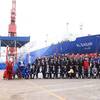Rig Moves: Mobilized for Performance
The operation of an oil field involves moving rigs or jackups in a maneuver referred to as a rig move. These complex operations require experience and the coordination of all stakeholders. Explanation by Pål-André Malø, superintendent for new construction, and former AHTS captain (Anchor Handling Tugs Supply) with Bourbon Offshore Norway.
"Generally speaking, this operation mobilizes between 3 and 4 vessels tasked with pulling the anchors of the rig to position it. Most of the time, there are 8 anchors - sometimes 10 or 12 - weighing 6 to 20 tons each," Pål-André explains.
Another technique, increasingly widespread, consists of carrying out a preliminary operation, called pre-lay. "This involves deploying anchors and moorings beforehand, to the new position site, to save time and increase accuracy."
It all starts with a safety meeting
Before each rig move, the stakeholders meet: captains of the AHTS vessels, tow masters, rig personnel, "The objective: to review the procedures and safety measures to be implemented," Pål-André explains. A Job Safety Analysis (JSA) is then performed, in addition to stability calculations, taking into account the maximum force that can be applied to the vessels during the rig move.
Time for action
Once the client has provided the anchor plan and the route to follow to the new position, the operation can now begin. Julien Querrer, chief mate aboard the AHTS Bourbon Thalie, says: "The first intervention is releasing 2 pairs of opposing anchors, by two vessels at the same time. In shallow waters, the AHTS vessels first retrieve the buoys connected to the anchors using a lasso. The buoy is brought onto the deck of the vessel, and its cable is connected to the winch. We can then disembed the anchor, i.e., extract it from the sea bottom and bring it onto the deck of the AHTS. In deepwater offshore, we use a chaser, a ring that slides along the cable attached to the anchor. For rig moves in deep waters, we may use an ROV to help carry out the operation. "
Once this operation is finished, the vessel approaches the rig so that it can retrieve each of the anchors with its cranes. When the last anchor is raised, upstream in the current, the lead vessel keeps the rig in position.
Then begins the towing phase to the new location.
"The two AHTS vessels adjust their position according to the indications of the rig mover, who is the person in charge of the final positioning of the structure," adds Julien Le Querrer. "The crane on the rig places the anchor onto the deck of the vessel before it gets too far away. The deck team then connects the anchor to the vessel's winch. We then begin the anchoring phase of the structure."
A rig move usually takes between 3 and 5 days, over highly variable distances. "When I was chief officer, I moved a rig from off the coast of Scotland to Angola!," says Pål-André Maløy.
Expert opinions
The experience of the teams plays a big role in the success of these operations. "A rig move is no trivial operation. It requires great coordination between all the players and strict implementation of security measures," Pål Andre concludes.















